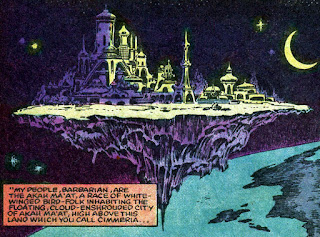 |
| Art by P.D. Breeding-Black |
In
The Chronicles of Talislanta (1987), our narrator the wizard Tamerlin starts his journey across the continent with Aaman in the Westernlands. The introduction of Aaman was actually in the
Talislanta Handbook published a month before. This, in summary, is what we are told about the Aamanians, and what holds true across every edition:
- Aaman is a remnant of the Phaedran Empire and a theocracy, ruled by conservative Orthodoxist faith, worshiping Aa the Omniscient (Or Omnipotent. Or Omnificent.)
- Aamanians are high conformist and dressing simply and conservatively, and removing all their facial and body hair.
- All Aamanians desire to attain mana, "so that they may rise in status and piety."
The Aamanians' skin color is the subject of some disagreement across publications. Character archetype descriptions in the 1st-3rd editions hold that they have "topaz skin and green eyes." The text of The Chronicles, however, describes them as having "skin the color of cinnabar," as does the Talislanta Worldbook of the 2nd edition. The 4th edition is the first to be internally consistent is this regard and goes with "cinnabar." With the 5th we are back to some discrepancy, with Hotan's History saying "cinnabar" and the Player's Guide saying "copper-colored."
 |
| Art from the French edition of Talislanta |
But that's a minor issue. What's more interesting is mana. The 1st edition Handbook tells us mana is accumulated by good works: "pilgrimages to officially sanctioned holy sites, donations to the church, service to the Hierophant, and so on." By gaining sufficient "mana points" one can advance in status. The Chronicles expands on this by telling us mana is "spiritual purity," and defines the hierarchy with the Hierophant with unlimited mana at the top, and the district-ruling (and mana awarding or deducting) Monitors beneath him having at least 1000 mana points. Slaves and infidels have 0 mana points, naturally, and between the extremes are ten ranks of Aspirants. Advancement in status by this measure is a "preoccupation" of Aamanians because position in the worldly Orthodox "caste system" corresponds to position in the after life in some unspecified way.
Material wealth enters into this as we are told the easiest way to obtain mana points is to enter into the priesthood and study to become an archimage--but tuition is high. In addition to the other means mentioned in the Handbook, buying statues, medallions, and relics is also a possibility.
The 2nd edition (in the Worldbook) tells us that "aalms" are the unit of mana (presumably the mana points mentioned). Reading all the texts, I am confused as to whether mana is a state or a thing to be accumulated. I suppose like the word sin, it might be employed both ways, though the analogy isn't perfect because counted sins are discrete entities, not a continuum that needs units to measure it, like say force or electric current.
The Cyclopedia Talislanta vol. 4 (1989) is now considered "noncanonical" for reasons various and not entirely clear, but it does have some interesting, detailed information on Aaman. It emphasizes the importance of wealth in determining status, presumably indirectly by the purchase power it allows to buy aalms. (Confusingly, it calls mana "the mystical unit of a person's worth.") It notes a requirement to buy a different symbol of Aa at each level of the Hierarchy.
The Cyclopedia is the first to address gender roles and places women as second class citizens in the hierarchy, making them always one status level below their husband or father.
 |
| Art by Jason Sholtis |
The oppressive theocracy is a genre staple, though Aaman never seems to dip into the "decadent or hypocritical theocracy." Instead, it seems to go in the direction of more secular totalitarian societies in science fiction. The aalms economy and rank system is interesting, too. It seems to have parallels to Scientology as well as the obvious ones to the indulgences of the Middle Ages.
I would leave out the sexism of the Cyclopedia; Aaman should be equal opportunity in its oppression. I would play up the extreme conformity and societal control, borrowing from Vance's The Pnume, and the speaking in aphorisms and quotations of liturgy mentioned in the text, almost to a degree that resembles the Ascians of Wolfe's The Book of New Sun. While material wealth would afford some advantages in maintaining one's position Aamanian society, I figure high mana is the key to getting wealth in the first place by leading to the award of lucrative positions, titles, and contracts, and some high mana individuals might wield considerable power without a lot of wealth.
Finally, despite what is possibly implied in The Chronicles, I lean toward the idea that Orthodoxy is aniconistic with regard to its deity--other than the eye. There is no commentary literature regarding the holy Omnival. The word means what the Hierophant says it means. Doctrine does change with time, but devout Orthodoxists will not admit a revision has ever occurred, indeed they may be strongly conditioned not to see it, even it it is pointed out to them.





















